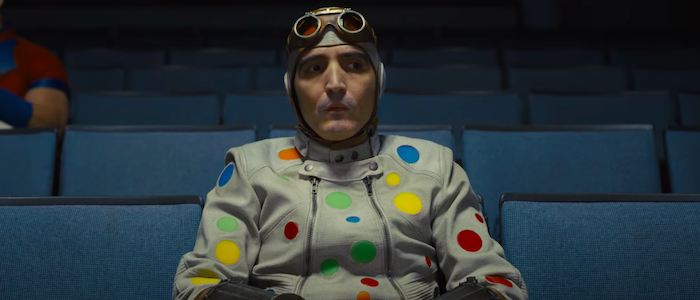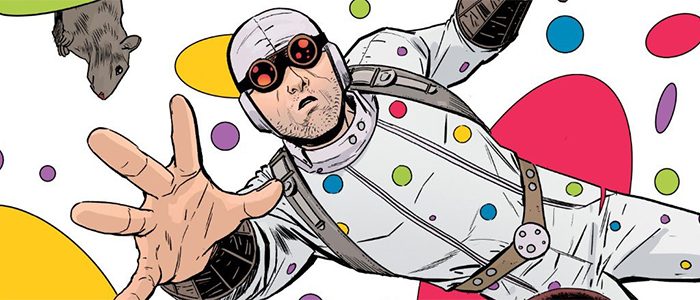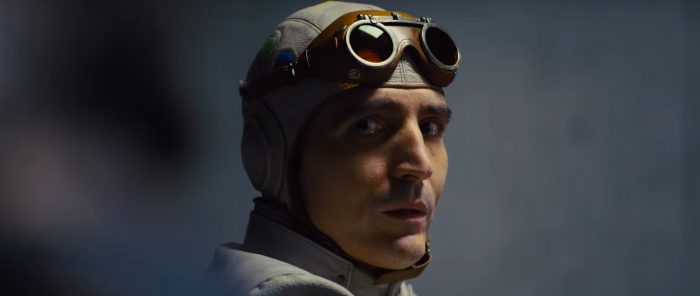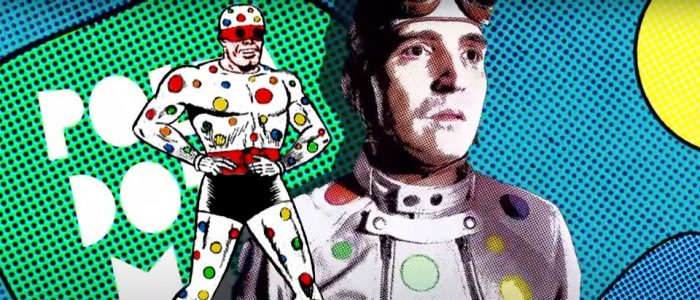
Polka-Dot Man isn’t the first character you’d think of as being the scene-stealer of a big tentpole superhero movie. A punchline maybe, or an early victim of The Suicide Squad‘s apparently high body count. And yet, there’s something behind that absurd polka dot costume and David Dastmalchian‘s mopey look as he audibly yearns for death that stirs the heartstrings. Couple that with director James Gunn‘s penchant for turning the most obscure comic book characters into movie icons, and well, you’ve got the recipe a new fan-favorite character.
When I visited the set of The Suicide Squad back in 2019, no character earned more chuckles and derision than Polka-Dot Man. Did that immediately make me want to protect him? Maybe. But it wasn’t just that which convinced me that Polka-Dot Man would be the obscure character of The Suicide Squad to achieve newfound superstardom à la Groot in Guardians of the Galaxy. It was the movie’s inventive approach to Polka-Dot Man’s very silly gimmick, and Dastmalchian’s obvious care for the character, that did the trick.

Who is Polka Dot Man?
To say that Polka Dot Man is one of the most ridiculed characters in DC Comics history might be an understatement. Introduced in Detective Comics #300 in February 1962, Polka-Dot Man was one of the many Batman rogues created by writer Bill Finger and artist Sheldon Moldoff who was built around a singular — often wildly stupid — gimmick. He…throws polka dots! And sometimes he can make them big and sharp!
Naturally, Polka Dot Man faded into obscurity after the Golden Age of Comics passed, apart from the occasional mention in a TV series or LEGO movie — when he was usually treated as a poorly aged punchline.

What’s So Special About Polka Dot Man in The Suicide Squad?
Even David Dastmalchian knows Polka-Dot Man won’t be on the top of people’s popularity lists. “Deep, deep, deep cut character. Literally voted like one of, I think, the least popular characters in all of the DC canon,” Dastmalchian told the group of journalists visiting the set of The Suicide Squad. And the unpopularity of the character gets worked into Dastmalchian’s portrayal of Polka-Dot Man, AKA Abner Krill, a metahuman who you could say is a bit of a sad sack:
“He doesn’t command a ton of respect out the gate. I think that, he’s somebody that hasn’t ever found much connectivity with people, because of certain things that I can’t discuss today, but also just because he’s Polka-Dot Man. I mean, that was the thing that worked for him, or he thought would work.”
But you know who are some of the most popular characters in current pop culture? Sad boys. Potentially even more beloved: sad boys who are paired up with dumb boys. Which may be why the team-up of Polka-Dot Man with King Shark (played in mo-cap by Steve Agee and voiced by Sylvester Stallone) is just another cherry on top for Polka Dot Man’s fated rise to popularity. “There’s a good number of things that we get to do together,” Dastmalchian teased of his and King Shark’s pairing in The Suicide Squad.
But as many sad boys are wont to do, Polka-Dot Man is not great making friends. You’d expect as much from a hardened criminal, but he’s as soft as you’d get, and one who feels more “disposable in a sense to the bigger scheme of operations.” (Insecurity and shame? Haven’t we all felt it!) Dastmalchian described Abner’s dynamic with the team:
“You have a group of exceptionally gifted or talented people at different varying degrees of strength or whatever their particular specialty might be, which might be useful, but they’re also people that are disposable in a sense to the bigger scheme of operations. And I think he’s always felt that way. So even if it’s [he’s] starting to feel like maybe there’s an alliance with some people, it’s a new feeling for Abner.”
Okay, Polka Dot Man is a relatable sad boy, you get it. But I probably haven’t yet convinced you of the character’s potential to be popular outside of my own vey specific tastes for fictional characters. Here’s where the most inventive and compelling part of his characterization comes in: his powers. Or rather, how his powers manifest as a painful disability — the dots are more than just a gimmicky weapon, but are part of a physical affliction that Abner suffers from, and which only his suit can keep under control. Dastmalchian compares the dots to having a disability, which affects Abner’s character completely:
“With the dots, and the way that when they can get out of hand, they can be literally like, almost look like sores on my body. It’s really intensely painful. So that absolutely helped shape how I was going to move and fight and sit, and do all the things that I’ll do in the film. And then again, how a disability or something that is considered that you’re embarrassed of, or that hurts you, finding a way that you can then suddenly do something with it that’s more than just suffer. Maybe it even could have a purpose. Then that changes the way you move, the way that you sit, the way you talk.”

Suited Up to Steal Hearts
With that new twist on the character, Gunn and Dastmalchian have turned a punchline character into a tragic character, which Gunn had said had been his goal from the beginning. And it’s also a chance for the production team to flex its muscles designing a grotesque look for Polka-Dot Man when he doesn’t have a suit to contain his…dots. Producer Peter Safran described them as painful “glowing pustules” which erupt around his face and body, all of which is done practically:
“One thing I should just mention on Polka-Dot Man, basically what you’ll discover in the movie is that the things you saw, the glowing pustules on his face and his body, he has to release those things twice daily, or they’ll eat him up from inside. But that look is all done practically. Legacy, who are doing a lot of our special effects make up, they built these… Each one is lit from within, wired down, controllable and all the different colors and everything, and it looks unbelievable.”
It’s only Polka-Dot Man’s suit that stops these pustules them from eating him alive, though it doesn’t necessarily contain them entirely, Dastmalchian said. “I would say it is a focusing mechanism for certain. Containment, no. Focusing, for certain. And elements, elements of the costume, which will be fun to discover, because that is a neat plot reveal, are weaponized in a really cool way.”
Polka Dot Man’s powers being both a disability and a weapon is such an intriguing take on the character, and one that Dastmalchian took very seriously. The actor is a longtime comic book fan, and has even appeared in the two prior superhero movies on both sides of the aisle, but The Suicide Squad gave him a chance to lend a depth to a character that had been long written off:
“The abilities that my character has… could be looked at in two ways, either as an ability or as a disability, as something that can cause excruciating amounts of pain and embarrassment. So, building out and fleshing out a character who, like I said to you guys earlier, something that I immediately found is like a kindred connection with Abner was this sense of how that would weigh me down. How pain can because a person’s body to kind of come inwards, and how shame can because a person’s body to come downward. So it was inward and downward was kind of like finding all my physicality for Abner.”
But, at the end of the day, a few people at the set visit still chuckled at the idea of Polka-Dot Man being a real player in the movie. “He’s fucking powerful, my friend,” Safran said. “Wait until you see him in action.”
***
The Suicide Squad hits theaters and HBO Max on August 6, 2021.
The post Prepare for Polka-Dot Man to Become Your Favorite ‘The Suicide Squad’ Character [Set Visit] appeared first on /Film.
0 Comments